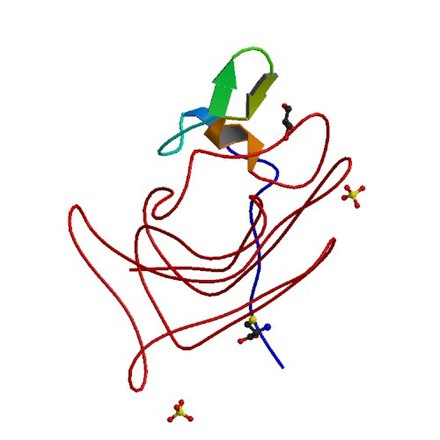Haemophilia
Haemophilia is a mostly inherited genetic disorder that impairs the body's ability to make blood clots, a process necessary to stop bleeding. This results in prolonged bleeding after an injury, easy bruising, and an increased risk of bleeding inside joints or the brain.

Signs and Symptoms
Characteristic symptoms of haemophilia vary with its severity. Generally, symptoms include internal or external bleeding episodes known as "bleeds". Individuals with severe haemophilia experience more frequent and severe bleeds, while those with mild haemophilia usually have minor symptoms unless triggered by surgery or trauma. Spontaneous bleeding is common in severe cases, with joint bleeds being the most characteristic type, potentially leading to permanent joint damage if untreated. Children with mild to moderate haemophilia may not display symptoms at birth but begin to show frequent bruises and haematomas from minor trauma as they grow.

Complications
Severe haemophilia can lead to multiple complications, such as deep internal bleeding, joint damage from haemarthrosis, transfusion-transmitted infections, adverse reactions to clotting factor treatment, and intracranial haemorrhage, which is a serious medical emergency.
Genetics
Haemophilia is typically inherited in an X-linked recessive manner, predominantly affecting males. Females are usually carriers unless they inherit two affected X chromosomes. Mutations in genes responsible for producing clotting factors VIII (haemophilia A) or IX (haemophilia B) lead to the condition. Spontaneous mutations account for a portion of haemophilia cases. Severity is determined by the level of active clotting factor, classified as severe, moderate, or mild.

Diagnosis
Haemophilia can be diagnosed through genetic testing and counselling before or during pregnancy, particularly if there's a family history. During pregnancy, tests like chorionic villus sampling (CVS) and amniocentesis can detect the haemophilia gene. Post-birth diagnosis is confirmed through blood tests, which can also classify the type and severity.
Classification
Types of haemophilia include haemophilia A (deficiency of functional clotting Factor VIII), haemophilia B (lack of functional clotting Factor IX), and haemophilia C (deficiency of Factor XI). Parahaemophilia, a rare form, is due to a deficiency in Factor V. Acquired haemophilia A is caused by autoantibodies against Factor VIII and can be associated with cancers and autoimmune disorders.
Management
Clotting Factors
Treatment involves replacing the missing clotting factors, particularly in moderate to severe haemophilia. Factors can be derived from human plasma or produced recombinantly. Preventative use of clotting factors is common in severe cases. Desmopressin (DDAVP) can be used in mild haemophilia A.
Other Treatments
Tranexamic acid or epsilon aminocaproic acid may be used to prevent clot breakdown. Pain management and physical therapy can help reduce joint pain and swelling. In cases of acquired haemophilia, corticosteroids and immunosuppressive drugs are effective.
Contraindications
Anticoagulants like heparin and warfarin are contraindicated in haemophilia. Activities with a high risk of trauma and sports with high injury rates should be avoided without medical consultation.
Prognosis
Life expectancy and quality of life for people with haemophilia have improved significantly with modern treatment. Historically, untreated haemophilia led to severely shortened lifespans. Today, with appropriate treatment, individuals can have near-normal lifespans.
History
Historically, haemophilia was known as the "royal disease" due to its prevalence in European royalty, passed down from Queen Victoria. Effective treatment became available in the 1960s with the discovery of cryoprecipitated AHF. The 1980s saw a significant risk of HIV/AIDS and hepatitis C from contaminated blood products, which has since been mitigated with improved screening and viral inactivation methods.


Research
Gene therapy is an emerging treatment for severe haemophilia, particularly haemophilia B. Recent trials have shown promising results, with gene therapies like Hemgenix and Roctavian approved by the FDA for haemophilia B and A, respectively. These therapies involve administering genetic information to produce the missing clotting factors, significantly reducing bleeding episodes.
Self-assessment MCQs (single best answer)
What is the primary cause of haemophilia?
Which clotting factor is deficient in haemophilia A?
What type of inheritance pattern does haemophilia typically follow?
Which type of haemophilia is caused by a deficiency in Factor IX?
What is a common treatment for mild haemophilia A?
Which of the following is NOT a complication of severe haemophilia?
What is the mainstay of treatment for severe haemophilia?
Which historical figure is associated with the spread of haemophilia in European royalty?
What recent treatment has been approved by the FDA for haemophilia B?
Which screening methods have improved the safety of blood products for haemophilia patients?
Dentaljuce
Dentaljuce provides Enhanced Continuing Professional Development (CPD) with GDC-approved Certificates for dental professionals worldwide.
Founded in 2009 by the award-winning Masters team from the School of Dentistry at the University of Birmingham, Dentaljuce has established itself as the leading platform for online CPD.
With over 100 high-quality online courses available for a single annual membership fee, Dentaljuce offers comprehensive e-learning designed for busy dental professionals.
The courses cover a complete range of topics, from clinical skills to patient communication, and are suitable for dentists, nurses, hygienists, therapists, students, and practice managers.
Dentaljuce features Dr. Aiden, a dentally trained AI-powered personal tutor available 24/7 to assist with queries and provide guidance through complex topics, enhancing the learning experience.
Check out our range of courses, or sign up now!


